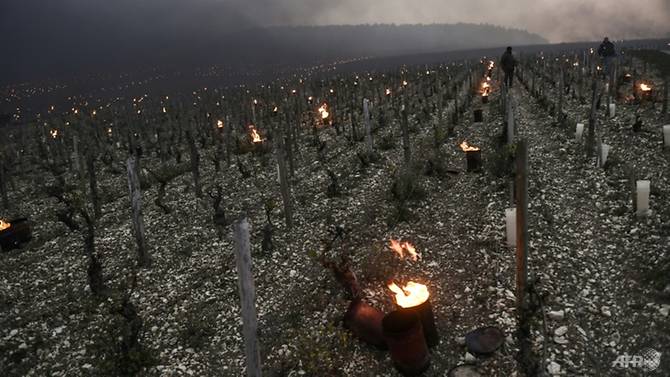France faces worst wine harvest since 1945
 |
| Wine growers light heaters early on April 21, 2017, in a Chablis vineyard hit by freeze near Auxerre, as the frost damaged part of French wineyards and orchards. (Photo: AFP/Philippe Desmazes) |
"At harvests everywhere, in places where we thought there would be a little less, there's a lot less," said Jerome Despey, the head of a governmental wine advisory board.
This year's harvest will be "the smallest since 1945," Despey told a news conference.
The agriculture ministry said output was expected to total 37.2 million hectolitres, 18 percent less than 2016 and 17 per cent below the average over the past five years.
The 2016 harvest was already one of the poorest in 30 years.
Despey said the ministry figures were based on assessments made early this month before the start of the harvests, which have now begun in the southeast, about two weeks earlier than usual.
Despey, who is also secretary general of France's biggest farmers union FNSEA, told AFP last week he expected a 40 per cent drop in output in the prime wine-growing region of Bordeaux, the country's largest.
Vineyards in northeastern Alsace, which produces mainly white wines, were also hard hit.
The new drop in production is "mainly attributable to the severe spring frost that affected all the wine-growing regions to varying degrees at a sensitive time for the vine," the agriculture ministry said.
The bitter cold struck twice within a week in April, ravaging the fragile shoots and buds that had emerged prematurely following mild temperatures in March.
To combat the frost, nervous winemakers in Bordeaux set fires in oil drums, then positioned them carefully between the rows of budding grapevines. Giant fans were also deployed to battle the cold, damp air settling on the plants.
Some losses are also anticipated in the Burgundy region, where the grapes have been repeatedly hit by hail in recent years.
Vineyards in the south, Beaujolais and the Rhone valley suffered an exceptionally dry summer that will further depress yields, the agriculture ministry said.
QUALITY, IF NOT QUANTITY
One advantage of drought is that it reduces the impact of diseases on the vines.
The maturity and good health of the grapes point to a "year 2017 that will stand out for quality, happily," Despey said.
In the five years to 2016, hail knocked out as much as half of Burgundy's harvest, according to the Global Wine Risk Index.
The index covers 110,000 wineries in 131 countries producing about 26 billion litres every year.
Switzerland, Austria, Germany and Hungary also suffered frost this year that could claim 30 per cent - up to 60 per cent in some parts - of the harvest in those countries.
Wine, which is one of France's top exports, is "a highly vulnerable industry," said researcher James Daniell of the Karlsruhe Institute of Technology in Germany.
About 10 per cent of wine production is lost to natural hazards every year at an estimated loss of US$10 billion, he said.
At the prestigious Vinexpo wine fair in Bordeaux in June, winemakers brainstormed over how to mitigate challenges to their livelihood posed by climate change.
Producers have found that global warming can cause grapes to ripen earlier, which changes their sugar and acid levels, leading to lower-quality wines with higher alcohol content.
Some are using low-tech approaches to delay harvesting times and increase soil moisture, experimenting with pruning later or using grape varieties that take longer to ripen, thrive in warmer climes or are resistant to drought.
But these grapes are not yet ready to be turned into great wines, experts say.
What the stars mean:
★ Poor ★ ★ Promising ★★★ Good ★★★★ Very good ★★★★★ Exceptional
Latest News
More News
- 72 nations sign landmark Hanoi cybercrime convention (October 26, 2025 | 18:00)
- UN Secretary-General commends Vietnam’s global leadership (October 26, 2025 | 09:00)
- APEC finance ministers convene to tackle regional challenges (October 22, 2025 | 17:31)
- Rewiring global trade: ASEAN’s rise as supply chain hub (October 17, 2025 | 11:40)
- Vietnam attends first World Nuclear Week Forum in Russia (September 26, 2025 | 10:50)
- Vietnam attends 69th session of IAEA General Conference (September 16, 2025 | 10:00)
- ADB, WB pledge over 12 billion USD for ASEAN power grid, renewable energy projects (August 15, 2025 | 14:18)
- Lowy Institute proposes AI-based tobacco control solutions for ASEAN (August 15, 2025 | 14:14)
- Cloud computing policy to position Malaysia as regional hub by 2030 (August 15, 2025 | 14:11)
- Thailand, Cambodia suffer numerous cyber attacks (August 05, 2025 | 16:19)

















 Mobile Version
Mobile Version